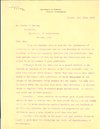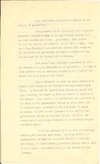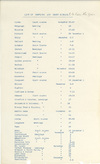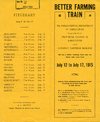“…planned on large and generous lines:” – The College of Agriculture and Extension Work
“It is true that the citizens of the province have built the University; it is also true that the University has had an important share in building the province.”1
There were several innovations in academic programs during Murray’s tenure as president: the Department of Ceramic Engineering in 1921 was the first in Canada; as was a class in electron theory and atomic structure, established in 1924. With the appointment of Professor Arthur Collingwood in 1931, the University of Saskatchewan became the only university west of Toronto and Montreal to have a music chair; the first outdoor school of art for university credit in Canada was opened at Emma Lake in 1936. Certainly, too, the vision for the University was always great in scope: of the current colleges, Graduate Studies, Kinesiology and Nursing are the only three not anticipated in 1909 (Murray did establish a School of Physical Education in 1929). However, two initiatives defined the University and its unique role in the province perhaps more than any others: the inclusion of Agriculture within the main campus, and the provincial government’s transfer of agricultural extension work to the University in 1910.
“…the sheet anchor of the University:” – Agriculture:

The University farm – as it undoubtedly looked at almost any point between 1912 and 1920. From the left: Engineering, the Stock Pavilion, farm workers’ residences and the Main Barn.
In his initial reply to the presidential search committee, Murray had clearly understood the connection between Agriculture and “the life of the province,” especially in helping to create a seamlessness between the work of the University and many of the province’s population. But he went further, expressing an overall vision for the new University:
I believe that the College of Agriculture, while distinct from the other Faculties and probably more isolated and independent, should yet be within the University, receiving from the liberal studies a humanizing influence and giving to the whole life of the University a sense of the close relationship between the daily life of the people and the pursuits of the scholar and the scientist. May Saskatchewan be as noted for its fine men and women as for its golden wheat. This expression of opinion may seem unnecessary but the question to me is important. For the answer to it will throw light upon the attitude of the people to higher education and their readiness to support a University planned on large and generous lines.
It cannot be overstated that inclusion of Agriculture within the main campus of the University was an absolute innovation at the time. Indeed, it took some convincing, even among the provincial Department of Agriculture; but once the merits of the case had been made, there was full support – including transfer to the University of “the two best men” in the Department, WJ Rutherford and John Bracken.
![Recommendation by Murray that Rutherford “be authorized to make such arrangements for summer fallowing the College Farm as he deems wise” and that “the Registrar be directed to issue cheques fortnightly in payment of the men employed [on] the farm.”](../thumbs/RG2008-75-4-p015.jpg) Recommendation by Murray that Rutherford “be authorized to make such arrangements for summer fallowing the College Farm as he deems wise” and that “the Registrar be directed to issue cheques fortnightly in payment of the men employed [on] the farm.”
Recommendation by Murray that Rutherford “be authorized to make such arrangements for summer fallowing the College Farm as he deems wise” and that “the Registrar be directed to issue cheques fortnightly in payment of the men employed [on] the farm.”
The College of Agriculture's original mandate was to provide resident teaching, agricultural investigation, and extension services to the province's farming community.
Forestry was included within the Board’s original expectations for Agriculture: one of the few academic concepts for the institution that never fully materialized.
 Letter from B.E. Fernow, dean of the Faculty of Forestry at UofT, 14 Dec 1908: regarding the development of a similar faculty at the U of S. He suggests a “desirable first step” would be “education to a proper attitude on the subject by citizens of all classes,” and provides three arguments to win citizens: first, any shortage of lumber or requirement for out-of-province supply of lumber “means inconvenience or dollars and cents out of their pockets.” Second, particularly for those settling in the north of the province, “the tree growth there…can be improved and perpetuated and will eventually prove a more valuable asset than even now;” and third, “The people in the plains and open prairie should be taught to grow trees for mitigating the winds and cheerlessness of treelessness.”
Letter from B.E. Fernow, dean of the Faculty of Forestry at UofT, 14 Dec 1908: regarding the development of a similar faculty at the U of S. He suggests a “desirable first step” would be “education to a proper attitude on the subject by citizens of all classes,” and provides three arguments to win citizens: first, any shortage of lumber or requirement for out-of-province supply of lumber “means inconvenience or dollars and cents out of their pockets.” Second, particularly for those settling in the north of the province, “the tree growth there…can be improved and perpetuated and will eventually prove a more valuable asset than even now;” and third, “The people in the plains and open prairie should be taught to grow trees for mitigating the winds and cheerlessness of treelessness.”
“A university province:” - Extension
There was nothing theoretical in Murray’s desire that the University should serve the people of the province: he intended practical advice and assistance, and a very direct connection between the campus and the public.
In 1910 the Saskatchewan Department of Agriculture turned over to the University the responsibility for the development and delivery of agricultural and women's extension programs throughout the Province. To fulfill this mandate, the Department of Agricultural Extension (1910) and Women's Work (1913) were established within the College of Agriculture. Initially the activities of Agricultural Extension focused on services to the Agricultural Societies – short courses, institutes, ploughing matches, field crop contests, stock judging, etc. During the war years, a Better Farming Train toured the province providing lectures and demonstrations and presenting exhibits on matters pertaining to agriculture. In 1915 “educational holidays” or camps were initiated for farm boys and girls and in 1918 4-H clubs were formed throughout Saskatchewan. Farm and Home Week, a period of exhibits, lectures, and demonstrations at the University, was introduced in the early 1930s. Special projects and programmes for rural women were offered through Homemaker's Clubs, established in 1911. In addition to basic domestic activities, women received advice and instruction in fruit growing, tree planting, home nursing, water supply and purity, libraries, health and welfare services, etc.
Footnote
1. Carlyle King, The First Fifty, p. 3
Related Items
Samples of Agricultural Extension bulletins produced by the University: PDF


